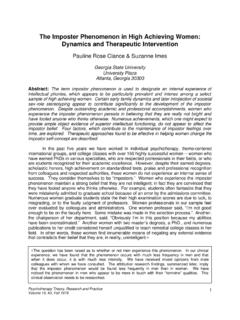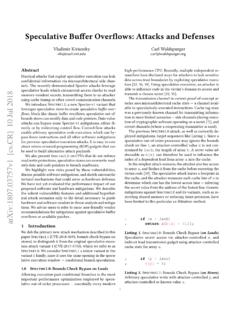Transcription of The History of Punishment By Lewis Lyons, published by ...
1 The History of Punishment By Lewis Lyons, published by Amber Books, 2003. The early History of Punishment begins with Gildamesh, the Samarian King of Uruk, who reigned around 2700 BC. The early Mesopotamian cultures were perhaps the first organized civilizations with permanent residences. The earliest legal code may have been that of Ur-Nammu, founder of the 3rd dynasty of Ur at about 2050 BC. It is interesting that in these early documents there was a reference to the power struggle between the temple and the state. In the Ur-Nammu code there are actually clear statements about if a person does something, what he will have to pay. Usually it has to do with paying a price in silver Mina. In some later Samarian records there was actually a death penalty given at a murder trial. In some early documents The Laws of Eshunna , there were different punishments for two social classes, the upper class and the lower class. The Laws of Eshunna appeared to cover every aspect of civil life including marriage, divorce, property, loans, inheritance, breach of contract, disputes and problems with harvest and cattle.
2 Punishments were forms of monetary compensation. There were, however, some capital offenses. The Code of Hammurabi was written around 1750 BC. Hammurabi Kingdom was centered in Babylon. Hammurabi erected public buildings, supervised irrigation and canal building, tax collection and created a postal service. Hammurabi unified his empire under a single legal code. By this code, the abiding principle was Talio which had to do for mutilating or amputating the part of the body that had committed a crime. There were legal rights and judicial procedures available to all in the kingdom. Cases were compiled and precedent was used as an argument. Still there were slaves and prisoners of war who did not have equal rights. The slaves, however, were paid a salary and could eventually purchase their own freedom. Under the Code of Hammurabi the death penalty was awarded for a vast array of crimes such as thievery, selling or receiving stolen goods, kidnapping, assisting fugitive slaves and for the sale of drink or even keeping a disorderly tavern.
3 The Code of Hammurabi was a source of two other Middle Eastern legal traditions; the Biblical Law of the Hebrews and Sharia, the Law of Islam. While the Ten Commandments summarized the citizen s duty under law, they however do not mention any Punishment and hence do not constitute a legal code. In the first five books of the Bible, known as the Torah (Law), Biblical punishments follow Hammurabi. Crimes under the Biblical laws were therefore a violation of God s will and must be punished. The legal tenants of the Torah were complimented by interpretations of the Mishnah (oral law) and the Talmud (an encyclopedic compilation of legal debates). The Mishnah was compiled and edited by Rabbi Judah ha-Nasi by the end of the 2nd century BC. The Talmud was compiled between 220 BC and 470 CE. The tenants of Jewish law have three purposes. They are retributive (punishing the criminal for his act), deterrent (severe enough to intimidate others from committing the crime) and expiatory (attempting to obtain God s forgiveness).
4 Punishments included imprisonment, banishment, sympathetic Punishment , flagellation and fines punished non-capital crimes. Imprisonment was reserved for repeat offenders who had been convicted twice before. Offenses against the person were punished by sympathetic Punishment ; the offender receives the same injury that he inflicted on his victim. Life for life, eye for eye, tooth for tooth, burning for burning. The Bible, Exodus 21:23 . Flogging was the preferred Punishment for a total of 168 offenses including seven types of incest and eight violations of dietary laws. Fines were reserved for property crimes and minor bodily injuries. Debtors were sold into bondage to pay off their History OF Punishment PAGE 2 debts. There were 36 capital crimes including murder, sexual offenses, idolatry, blasphemy and desecration of the Sabbath. Witchcraft was also a capital crime. The Bible lists three methods of execution; stoning, burning and decapitation. Stoning was the most common method used mainly for crimes that affected the well being of the whole community including sex crimes.
5 Death by burning was the Punishment for nine categories of incest and one of adultery-that of sex with a married daughter of a priest. Decapitation was reserved for willful murderers and those convicted of communal apostasy (the renunciation of religion). Capital cases had to be tried by at least 23 judges who needed a majority of at least two to convict. Arabia eventually became the cradle of Islam and these people were known as Arabs since the 1st century, CE. The word, Islam, means submitting or surrendering. Islam is a conservative religion that requires total obedience to God and Islamic Law. In about 570 Mohammed ibe Abdullah was born in Mecca. In 610 Mohammed saw a vision of the Angel Gabriel who told him that he was the apostle of God. Mohammed began preaching that Allah was the only God. In 630 Mohammed s followers captured Mecca. Sharia means the clear path or highway and is the law of the Islamic world. These laws, as in Judaism, are considered to be of Divine origin and governs ritual, belief and actions down to the last detail of life.
6 Sharia is based primarily in the Koran which is the Revealed Word of God. In Sharia the judges often have discretionary punishments which allows them to make various punishments for the same crime. In the Islamic Law there are crimes with specific punishments (Hadd), crimes whose Punishment is at the judges discretion (Ta-Zir), crimes that deserve retaliatory action (Kisas) inflicted by the victim s family or blood money paid by the offender or his family, crimes against the policy of the state deserving administrative penalties (Siyasa) and crimes that are corrected by acts of personal penance or expiation (Kaffara). Punishments may be death by stoning, fines, lashes, amputations. Apostasy, renouncing Islam by word or deed, is detrimental to the faith of other Muslims and the penalty is death. It has been said of the Romans that their greatest legacy was their law. The Romans acquired much of their law from the Greeks. The Greek Laws often had their background in the Code of Hammurabi.
7 In Athens, the poet Hesiod, agitated for a written code that would protect the rights of all citizens. Pressures in 621 BC led Draco to compile a legal code promoting stability and equality. Draco, whose name is the origin of the word draconian , embraced the notion of state Punishment rather too enthusiastically. His code mandated the death penalty for virtually all crimes even minor ones such as petty theft. Salon reformed Draco s code in 594 BC. Rome eventually constructed Twelve Tables in 450 BC. The aim of the TT (Twelve Tables) was to ensure the rights of the average citizen. The Twelve Tables mandated the death penalty for a number of crimes including theft by night in the city and treason. Debtors could be punished by being sold into slavery but had to be sold abroad. The Twelve Tables set out trial procedures that were followed throughout the years for the republic and the empire. It was compulsory for witnesses to attend trial when summoned. A later provision called for honesty and impartiality among judges and stipulates the death penalty for judges found guilty of accepting bribes.
8 These Roman laws changed over the years as the empire grew. In the 3rd century BC a police force was introduced and in the 2nd century BC a permanent court system began to develop. When the History OF Punishment PAGE 3 Roman Empire was split in the 5th Century of the Christian era between Constantinople and Rome. The Byzantine emperor, Justinian, (483 CE to 565 CE) compiled a body of civil law called the Code of Justinian. Much of these laws lasted to the end of the 19th century in Europe and were the model for the French Code of Napoleon and the laws of Germany. One tenant of the Codex Justinianus was The burden of proof is upon the party affirming, not the party denying . The main punishments in the republic and the empire were execution, exile, corporal Punishment , imprisonment and fines. The method of execution included burning, stoning, crucifixion, the furca (hanging from a large fork until dead) and being thrown to the animals. Crucifixion was the standard method of execution for slaves and low ranking foreigners.
9 Torture was not permitted against high ranks but was used judicially against slaves. The legal traditions of India and China developed independently of those of Europe and the Mideast. Common documents of Indian Law, called the Laws of Manu, compiled in the 1st or 2nd century CE and the Chinese Tang Code written in the 8th century. The Laws of Manu were never universally applied all over India but the Tang Code was a blueprint for the Imperial Codes for one thousand years all over China and was supported by a vast empire-wide civil service. When the Aryans from Persia invaded India shortly before 2000 BC they brought with them a social structure which divided society into four classes. Each class had its own rules and position within society and there was limited movement between the classes. Hinduism helped to harden the distinction between the castes. The system was designed to maintain the racial purity of the Aryan noble and Brahman castes. Treatment of a criminal was inextricably bound up with the circumstances of his or her birth.
10 The Laws of Manu evolved from about 500 BC into the 2nd century CE. Sutras were manuals of instruction composed by religious teachers for their students. The Sutras expounded the correct rules, laws, customs and rights for every aspect of life. Punishment of a crime was essential for a soul s passage through life and afterlife. It was crucially important to make sure that justice was properly done. He who raises his hand or a stick shall have his hand cut off; he who in anger kicks with his foot shall have his foot cut off . Laws of Manu. In cases where there were no witnesses, trial by ordeal was used to determine guilt. Trial by ordeal might include hot water and even boiling cow dung where a person was asked to bury his arm in the dung. If he escaped being burned he was innocent. In trial by poison the accused was blindfolded and made to retrieve a ring from a basket containing a poisonous snake. In trial by fire he had to walk through fire or carry a hot, iron ball.





